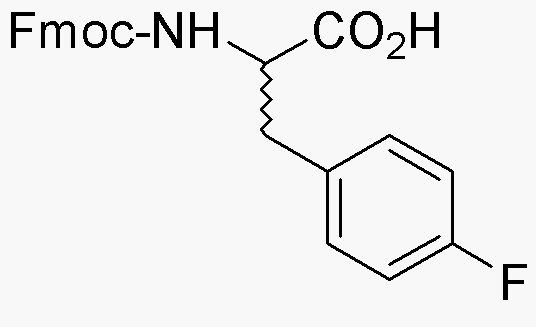Fmoc-4-fluoro-DL-phenylalanine is widely utilized in research focused on
- Peptide Synthesis: This compound is a key building block in the synthesis of peptides, particularly in solid-phase peptide synthesis (SPPS), allowing for the incorporation of fluorinated amino acids that can enhance the stability and bioactivity of the resulting peptides.
- Drug Development: Its unique properties make it valuable in the pharmaceutical industry for developing novel drugs, especially those targeting specific biological pathways where fluorine substitution can improve pharmacokinetics.
- Bioconjugation: The chemical is used in bioconjugation processes, enabling the attachment of peptides to other biomolecules, which is crucial for creating targeted therapies and diagnostic agents.
- Research in Protein Engineering: Researchers utilize this compound to study protein folding and stability, as the fluorine atom can influence the interactions within protein structures, providing insights into protein behavior.
- Fluorinated Compound Studies: It serves as a model compound in studies exploring the effects of fluorination on biological activity, helping scientists understand how modifications can lead to improved therapeutic profiles.
Informations générales
Propriétés
Sécurité et réglementation
Applications
Fmoc-4-fluoro-DL-phenylalanine is widely utilized in research focused on
- Peptide Synthesis: This compound is a key building block in the synthesis of peptides, particularly in solid-phase peptide synthesis (SPPS), allowing for the incorporation of fluorinated amino acids that can enhance the stability and bioactivity of the resulting peptides.
- Drug Development: Its unique properties make it valuable in the pharmaceutical industry for developing novel drugs, especially those targeting specific biological pathways where fluorine substitution can improve pharmacokinetics.
- Bioconjugation: The chemical is used in bioconjugation processes, enabling the attachment of peptides to other biomolecules, which is crucial for creating targeted therapies and diagnostic agents.
- Research in Protein Engineering: Researchers utilize this compound to study protein folding and stability, as the fluorine atom can influence the interactions within protein structures, providing insights into protein behavior.
- Fluorinated Compound Studies: It serves as a model compound in studies exploring the effects of fluorination on biological activity, helping scientists understand how modifications can lead to improved therapeutic profiles.
Documents
Fiches de données de sécurité (FDS)
La FDS fournit des informations de sécurité complètes sur la manipulation, le stockage et l’élimination du produit.
Spécifications du produit (PS)
Le PS fournit une description complète des propriétés du produit, notamment sa composition chimique, son état physique, sa pureté et les exigences de stockage. Il détaille également les plages de qualité acceptables et les applications prévues du produit.
Certificats d'analyse (COA)
Recherchez des certificats d'analyse (COA) en saisissant le numéro de lot du produit. Les numéros de lot et de lot se trouvent sur l'étiquette d'un produit, après les mots « Lot » ou « Lot de fabrication ».
Numéro de catalogue
Numéro de lot/série
Certificats d'origine (COO)
Ce certificat d'exploitation confirme le pays dans lequel le produit a été fabriqué, et détaille également les matériaux et composants utilisés et s'il est issu de sources naturelles, synthétiques ou autres sources spécifiques. Ce certificat peut être requis pour les douanes, le commerce et la conformité réglementaire.
Numéro de catalogue
Numéro de lot/série
Fiches de données de sécurité (FDS)
La FDS fournit des informations de sécurité complètes sur la manipulation, le stockage et l’élimination du produit.
DownloadSpécifications du produit (PS)
Le PS fournit une description complète des propriétés du produit, notamment sa composition chimique, son état physique, sa pureté et les exigences de stockage. Il détaille également les plages de qualité acceptables et les applications prévues du produit.
DownloadCertificats d'analyse (COA)
Recherchez des certificats d'analyse (COA) en saisissant le numéro de lot du produit. Les numéros de lot et de lot se trouvent sur l'étiquette d'un produit, après les mots « Lot » ou « Lot de fabrication ».
Numéro de catalogue
Numéro de lot/série
Certificats d'origine (COO)
Ce certificat d'exploitation confirme le pays dans lequel le produit a été fabriqué, et détaille également les matériaux et composants utilisés et s'il est issu de sources naturelles, synthétiques ou autres sources spécifiques. Ce certificat peut être requis pour les douanes, le commerce et la conformité réglementaire.


